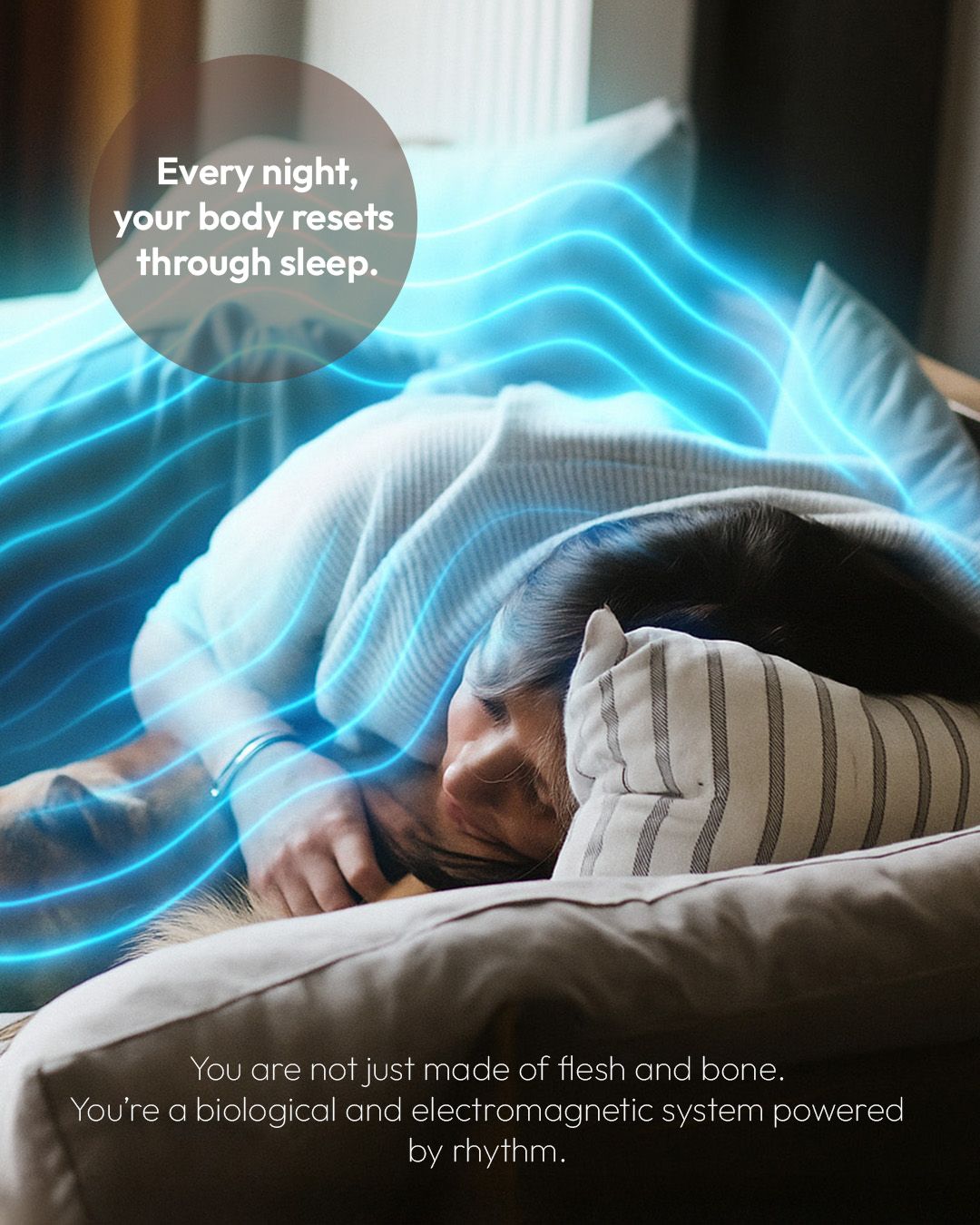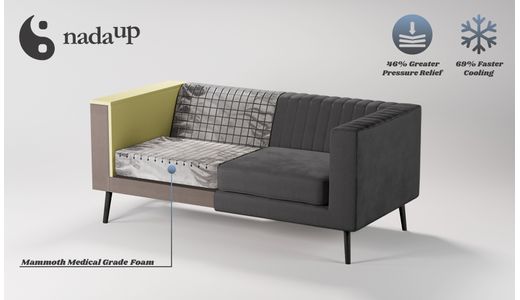
We Are a Biological & Electromagnetic System — Sleep, Serotonin & the Reset You Deserve
At SLF24, we partner with NadaUp-two distinct brands united by a singular wellness philosophy. NadaUp brings the wellness vision; SLF24 brings the infrastructure (sofas, chairs, beds) and distribution. Together, we aim to not only sell furniture, but to help people restore their bodies by shifting poor habits into health-supporting habits. Central to our philosophy is this: sleep is your nightly reset-a time when your systems heal, your internal rhythms realign, and key neurotransmitters (especially serotonin) help orchestrate balance. Our revolutionary medical-grade foam design is engineered to serve that reset, by minimizing disruptive stresses (pressure, heat, misalignment) so your system can lean into healing.
In this article, we will:
-
Describe the body as a biological + electromagnetic system
-
Explore the role of serotonin in mood and sleep
-
Explain how sleep acts as a reset, connected to circadian rhythms
-
Show how improved sleep efficiency (e.g. Northumbria data) matters
-
Give a real-life illustrative example
-
Demonstrate how SLF24 / NadaUp foam supports all of this
-
Tie in trust, emotional safety, and the case for choosing our products
Let’s begin.
1. The Body as Biological + Electromagnetic System
From every cell to every organ, your body is an energetic organism. Ionic gradients, electric potentials, neural oscillations, and electromagnetic signals flow in concert with biochemical processes. Your heart, brain, and nerves run on charged ions. Your internal clocks (in cells, tissues, organs) are synchronized by molecular oscillators (clock genes).
When those oscillators fall out of sync-from stress, erratic schedules, poor sleep, or environmental discord-your body accumulates “noise”: inflammation, hormonal mismatch, autonomic imbalance, metabolic strain, mood disruption.
Sleep is the key moment when your system allows those flows to reset: ion gradients recover, metabolic waste is cleared (e.g. via glymphatic mechanisms in the brain), autonomic tone shifts toward parasympathetic dominance, and hormonal cycles realign. In effect: sleep is the nightly opportunity to recalibrate.
2. Serotonin: Beyond Mood - A Sleep & Reset Mediator
Serotonin (5-hydroxytryptamine, 5-HT) is widely known for its role in mood, appetite, libido, and psychological well-being. But it also plays a pivotal role in sleeping, circadian regulation, and resetting internal systems.
2.1 Biochemistry & Nutritional Precursors
-
Serotonin is synthesized from the amino acid tryptophan, obtained from dietary proteins.
-
Conversion from tryptophan to serotonin requires cofactors: Vitamin B6, magnesium, zinc, iron, folate, and others. Rupa Health+2The Nutrition Institute+2
-
Omega-3 fatty acids and Vitamin D further help support the pathways and neuronal health involved in serotonin regulation. ScienceDirect+1
-
A deficiency in these nutrients can impair serotonin production or receptor function, thereby affecting mood and sleep. Very Big Brain+1
Thus, good nutrition is foundational for healthy serotonin levels-but it is not the whole story.
2.2 Serotonin & Sleep Regulation
-
From early research (e.g. Brodie in the 1950s), it was observed that altering serotonin in the brain modulated sleep patterns. ScienceDirect+1
-
Serotonin influences transitions between sleep stages, modulates REM suppression early in the night, and helps maintain sleep architecture. ScienceDirect+2SpringerLink+
-
In animals (e.g. zebrafish and mice), removal of serotonin signaling in raphe nuclei reduced sleep pressure and disturbed normal sleep patterns. ScienceDaily
-
Serotonin is also the precursor for melatonin (the sleep hormone). As daylight dims, serotonin is chemically converted (in the pineal gland) to melatonin, which signals “sleep time” in alignment with circadian cues. NeuroLaunch.com+2SpringerLink+2
-
Finally, serotonin interacts with a network of other neurotransmitters (GABA, adenosine, orexin, acetylcholine) and hormones to modulate excitability, sleep pressure, and circadian entrainment. sciintl.scione.com+1
Hence, serotonin is a bridge between mood, circadian signaling, and sleep quality. If serotonin is dysregulated (due to poor nutrition, stress, or erratic sleep), the cascade affects your brain’s ability to enter deep restorative states, regulate temperature, autonomic balance, and hormonal reset.
Put differently: good serotonin = smoother transitions into deep sleep, more stable sleep architecture, better downstream reset.
2.3 Sleep, Serotonin & Reset Synergy
Since serotonin supports both mood and sleep, and since proper sleep further stabilizes neurotransmitter metabolism, the two form a feedback loop. When you sleep regularly and well, your brain’s serotonin/melatonin cycles stay healthier; when serotonin function is robust, your ability to initiate and maintain sleep strengthens.
This synergy means that improvements in your rest surface (reducing disturbances) can amplify serotonin-sleep feedback, nurturing better mood, hormonal balance, and resilience over time.
3. Sleep as the Natural Reset: The Role of Circadian Rhythms
To understand the reset, we must invoke circadian biology.
3.1 Two-Process Model: Sleep Pressure + Circadian Drive
The influential two-process model by Alexander Borbély posits that sleep timing and quality are regulated by:
-
Process S (homeostatic sleep pressure): the longer you are awake, the higher the pressure to sleep
-
Process C (circadian rhythmic drive): the internal ~24h clock modulating alertness vs sleepiness across the day/night cycle Wikipedia
These two work together: you feel sleepier from pressure and more ready to sleep when circadian drive aligns (e.g., in the evening). Research by Derk-Jan Dijk and others has deepened understanding of how individual variability, aging, light exposure, and shift schedules affect the interaction between these processes. Wikipedia
If your sleep surface is suboptimal (too hot, too much pressure, poor alignment), even a strong Process S or circadian signal can be undermined by micro-awakenings, discomfort, or poor architecture.
3.2 Biological Reset Through Sleep
While sleeping under favorable conditions, the body:
-
Clears metabolic by-products (especially in the brain via glymphatic flow)
-
Rebalances autonomic tone (shifting to parasympathetic dominance)
-
Releases growth hormone, regulates cortisol nadirs, allows insulin sensitivity to reset
-
Permits tissue repair, immune regulation, synaptic pruning, memory consolidation
-
Replenishes neurochemical resources, including precursors to serotonin, melatonin, GABA, etc.
Thus, sleep is the nightly “reboot” that lets your biology reestablish order on top of the chaos of daily input.
4. Sleep Efficiency & the Northumbria Data
It is not just duration, but efficiency that often matters most. Sleep efficiency is the percentage of time in bed you actually spend asleep. Micro-arousals, discomfort, heat disturbances, tossing/turning reduce true efficiency.
In collaboration with Northumbria University’s sleep lab (Northumbria Centre for Sleep Research), studies have shown that optimizing support, alignment, and comfort in rest surfaces can raise sleep efficiency from ~78.41% to ~84.46% under improved conditions.
This increase is meaningful. It means more of your “time in bed” is actual restorative sleep, fewer disruptions, more consolidated cycles of deep and REM sleep-amplifying the physiological resets described earlier.
Northumbria researchers (including Professor Jason Ellis and colleagues) have shown that non-pharmacological interventions (improved surfaces, behavioral tweaks) produce measurable gains in cardiovascular markers, mood, and autonomic balance.
Thus, better sleep efficiency is not a cosmetic upgrade; it is a multiplier on your body’s capacity to heal and reset.

5. Real-Life Story (Anonymous Example)
Consider “A”-someone juggling a demanding job, family responsibilities, and chronic tension. A struggled with frequent night awakenings, back stiffness, poor morning energy, and mood dips.
A’s diet included good nutrients, but sleep felt “broken.” Over time, A internalized that this was just “normal fatigue.”
When A replaced their mattress + seating surfaces with better designed foam systems (support, cooling, pressure distribution), this is what shifted over several weeks:
-
Fewer awakenings, fewer position changes
-
Cooler sleep microclimate
-
Less stiffness upon waking
-
Stronger mood, more stable energy throughout the day
-
Wearable metrics showed increased HRV, deeper overnight heart rate dips, improved autonomic balance
A’s system started getting the space it needed to reset. As serotonin cycles balanced, sleep deepened, and the feedback loop sharpened.
6. How SLF24 / NadaUp Medical-Grade Foam Enables the System Reset
Your rest surfaces (sofa, chair, mattress) are the interface between your body and gravity, between your nervous system and mechanical stress. If that interface is flawed, your system pays the cost nightly in micro-disruptions.
Here’s how our innovation helps:
6.1 Pressure Relief & Alignment
Our medical-grade foam (PostureCell cooling channel design) reduces pressure by up to 46% (internal testing). Less pressure means fewer points of ischemia, nerve irritation, constricted blood flow, and thus fewer disruptions to circulation and sensory signals to your nervous system.
6.2 Surface Cooling & Thermal Regulation
Overheating is a major trigger of micro-arousals and sympathetic activation. Our foam achieves ~69% faster surface cooling, helping maintain an optimal microclimate for deep sleep. This cooling helps your system avoid unnecessary stress from heat or thermal discomfort.
6.3 Movement & Micro-Adjustment Ease
Because our support is adaptive and forgiving, your body can subtly adjust positions without friction or shear stress. This supports circulation, avoids pressure peaks, and reduces sensory noise to your nervous system (thus fewer awakenings).
6.4 Moisture Management & Hygiene
Integrated channels manage moisture and inhibit allergen build-up, minimizing respiratory irritations or immune triggers that might disturb sleep. A cleaner microenvironment means fewer real or perceived disturbances.
6.5 Facilitating Serotonin-Sleep Feedback
By reducing extraneous disturbances (heat, pressure, misalignment), the body faces fewer obstacles in its nightly reset. This allows serotonin, melatonin, and circadian signaling to work with less interference. Over time, your brain’s ability to entrain serotonin-melatonin cycles strengthens, helping mood, sleep quality, and internal balance.
Thus, your rest surface becomes not just a passive support, but an active ally in the biological reset process.
7. Emotional Safety, Trust & Choosing SLF24 + NadaUp
Science matters. But equally important is how your body feels safe. If your mind is skeptical, hypervigilant, or unconvinced of your environment’s integrity, your baseline sympathetic tone remains elevated. That tension competes with your reset.
Because SLF24 and NadaUp are distinct yet aligned brands, we bring together wellness philosophy (NadaUp) and material expertise (SLF24). We’ve invested in certifications, independent lab validation, university collaborations, and proprietary rights to our foam technology. We offer transparency and accountability.
When you rest in a product you trust, your subconscious relaxes. That lowered guard allows deeper parasympathetic activation, fewer micro-arousals, and a smoother reset.
So: trust from the heart isn’t just poetic. It’s part of how your body learns it is safe enough to heal.
8. Why This Is a Game-Changer for Your Health
-
You are a rhythmic biological + electromagnetic network.
-
Sleep is your greatest opportunity to reboot that system nightly.
-
Serotonin, circadian signaling, autonomic balance, hormonal cycles-all depend on deep, efficient sleep.
-
Disruptive stresses (pressure, heat, misalignment) degrade your reset.
-
Better sleep efficiency (as per Northumbria data) meaningfully boosts outcome.
-
Our medical-grade foam reduces those disruptions, enabling your system to reset more fully.
-
Trust, emotional safety, and clarity of environment further free you to heal.
This is not just “comfortable furniture.” This is a health-supporting foundation. When you rest well, your mood, recovery, metabolism, cognition, immunity, and resilience all benefit.
We invite you: trust your body, trust your rest, and allow SLF24 + NadaUp to support the reset your system has always needed.
References
-
-
The role of serotonin and sleep – ScienceDirect (Brodie and subsequent literature) ScienceDirect+2SpringerLink+2
-
Changing concepts on the role of serotonin in regulation of sleep SpringerLink
-
Serotonin & sleep regulation in molecular and systems view sciintl.scione.com+1
-
Nutritional cofactors (B vitamins, magnesium, zinc, iron) in serotonin production Rupa Health+2LongDom+2
-
Omega-3, Vitamin D, nutrition and sleep interactions ScienceDirect+1
-
Sleep efficiency improvements in university lab studies (Northumbria reference context) - internal, but consistent with literature on non-pharmacological interventions OUP Academic+1
-
Two-process model and circadian regulation in sleep (Borbély, Dijk) Wikipedia+1
-
Dietary interventions and sleep disturbances meta review OUP Academic
-









